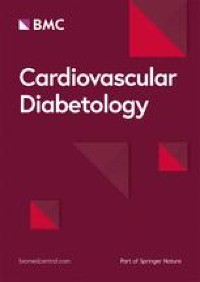Cardiovascular
Association of prior outpatient diabetes screening with cardiovascular events and mortality among people with incident diabetes: a population-based cohort study
Study design and setting
This was a population-based cohort study using health administrative databases in Ontario, the most populous province of Canada. Permanent residents of Ontario receive physician and hospital services through the publicly-funded Ontario Health Insurance Plan (OHIP).
Study population
We included permanent residents aged ≥ 20 years with incident non-gestational diabetes diagnosed between January 1, 2014 and December 31, 2016. We excluded individuals with any previous hospitalization for myocardial infarction, stroke, coronary revascularization (percutaneous coronary intervention or coronary artery bypass graft surgery).
Data sources
We used the Ontario Diabetes Database (ODD), which includes Ontario residents with physician-diagnosed diabetes. Non-gestational diabetes was identified by having 3 OHIP physician billing claims for diabetes within 1 year (validated positive predictive value 91.4%), excluding claims occurring within 120 days before or 180 days after a pregnancy-related hospitalization [7]. Cases with a diagnosis date prior to January 1, 2014 were excluded, to ensure that only incident cases were included. Outpatient laboratory testing results were retrieved from the Ontario Laboratories Information System (OLIS) database, a province-wide, centralized repository of results from community, hospital, and public health laboratories [8].
Demographic information was obtained from the Registered Persons Database (RPDB). History of cardiovascular disease, other baseline co-morbidities and primary care utilization (defined as the number of visits to a family doctor in the year prior to diabetes diagnosis) were determined from the Canadian Institutes of Health Information (CIHI) Discharge Abstract Database, the CIHI Same-Day Surgery database, OHIP database, National Ambulatory Care Reporting System and Ontario Mental Health Reporting System (Additional file 1: Table S1). Since we did not have information on individual-level smoking status and income [9], neighbourhood-level smoking rates and income levels from the Canadian Community Health Survey (CCHS) and Canadian census data were used as proxies. All datasets were linked using unique, encoded identifiers and analyzed at ICES.
Exposure
As physician-diagnosed diabetes was required for entry into the cohort, all individuals in the study would have undergone some form of diabetes testing by default. However, our exposure of interest was outpatient diabetes screening performed prior to the diagnosis of diabetes. Diabetes Canada recommends that those targeted for screening should be tested every 3 years in general, or more frequently for individuals with an especially high risk of diabetes [1]. Therefore, we defined prior outpatient screening as having an outpatient diabetes screening test performed in the 3 years preceding the diagnosis of diabetes (Additional file 1: Figure S1). We excluded any screening tests occurring within 90 days before the date of diabetes diagnosis (“washout” period), based on our assumption that tests within this period would have contributed directly to the diagnosis of diabetes [10]. For example, an individual who received outpatient diabetes screening for the first time, and was diagnosed with diabetes within the next 90 days, would be classified as having no prior outpatient screening. If more than one eligible screening test was performed, then we used the result of the most recent eligible test only.
We included all 3 tests for diabetes screening: glycated hemoglobin (HbA1c), fasting plasma glucose (FPG), and 2-h plasma glucose after 75 g oral glucose tolerance test (OGTT) [11]. The most recent prior outpatient diabetes screening test result was classified as “normoglycemic range” (HbA1c < 6.0%, FPG < 6.1 mmol/L, OGTT < 7.8 mmol/L), “prediabetes range” (HbA1c 6.0–6.4%, FPG 6.1–6.9 mmol/L, OGTT 7.8–11.0), and “diabetes range” (HbA1c ≥ 6.5%, FPG ≥ 7.0 mmol/L, OGTT ≥ 11.1 mmol/L) [12]. Classification in the “diabetes range” on a prior screening test was not considered as a diagnosis of diabetes, because diagnosing diabetes requires at least 2 positive tests on different days, in the absence of symptomatic hyperglycemia [11]. The primary exposure variable was prior screening versus no prior screening. The secondary exposure variable was prior screening result (diabetes range, prediabetes range, normoglycemic range), limited to those who received prior screening. We excluded tests performed during the last 20 weeks of pregnancy or during hospitalization, as our focus was non-pregnant outpatient diabetes screening.
Outcomes
The co-primary outcomes were (1) a composite of all-cause mortality and hospitalization for myocardial infarction, stroke, coronary revascularization (percutaneous coronary intervention or coronary artery bypass graft surgery), and (2) all-cause mortality. Secondary outcomes included each component of the co-primary composite outcome aside from mortality, hospitalization for heart failure, and hospitalization for unstable angina. We followed individuals to the earliest occurrence of the outcome, death, departure from the province, and December 31, 2018 (final follow-up date).
Statistical analysis
We described the baseline characteristics of the study population. Rates of each outcome were calculated as age and sex-standardized rates per 1000 person-years of follow-up, standardized to the 2016 Ontario census population. We used Cox proportional hazards models to determine the adjusted hazard ratios (HR) for each of the exposures with mortality. We adjusted for pre-specified, clinically significant confounding variables including age, sex, neighbourhood income quintile, hypertension, dyslipidemia, neighbourhood smoking, cancer, asthma or COPD, peripheral vascular disease, dementia, liver disease, chronic kidney disease, primary care utilization, and hospitalization or emergency department visits for mood or psychotic disorders. We repeated the analysis for the other outcomes, using cause-specific hazard models to account for the competing risk of death [13]. Because screened individuals with prior normoglycemia had higher than expected mortality rates, we conducted an exploratory post-hoc analysis of their causes of death. All analyses were performed using SAS version 9.4 (SAS Institute, Cary, NC) and 2-sided p-values < 0.05 considered significant. The use of the data in this project is authorized under section 45 of Ontario’s Personal Health Information Protection Act (PHIPA) and does not require review by a Research Ethics Board.

